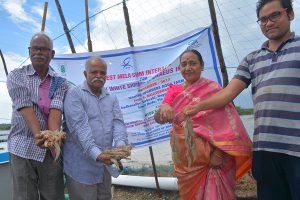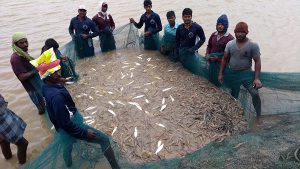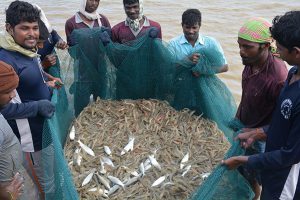Scientists from ICAR-Central Institute of brackishwater aquaculture (CIBA), a premier research institute in the country, are exploring ways to increase farmer’s profitability by promoting species diversification. Though exotic shrimp vannamei has totally captured coastal aquaculture diaspora contributing almost 4.06 lakh tonnes with Rs 26,000 crores, this has its demerit as single species and imported broodstock dependence and emerging disease problems (like EHP, white fecal disease) besides loss due to viral diseases -WSSV etc. It is more appealing to try out new avenues and species when farmers are failing to get successful shrimp crop due to extreme physicochemical condition (high salinity) and disease prevalence. Research are conducted at ICAR-CIBA to assess the performance of the Indian white shrimp P. indicus, which is native of India, in terms of growth, productivity, etc., in comparison with non-native shrimps. Successful farming trials of this desi shrimp have been conducted in many maritime states (Odisha, West Bengal, Andhra Pradesh, Tamil Nadu, Kerala and Gujarat) under National Fisheries Development Board (NFDB) funded project to demonstrate and promote this indigenous species as an complementary species as envisaged under “Make in India” programme.
A partnership farming model of Indian white shrimp P. indicus was taken up in Radhanallur (Shirkhali, Nagapattinam) with Mr S. Balasubramanian (Marine wonders Aquafarm) under the project. The farming inputs such as seed and feed (‘indicus plus’) and technical know-how were provided by the institute. The culture was successfully demonstrated during August to November through the North East monsoon season. This culture was taken up in the Sirkazhi taluk (Radhanallur cluster) with an area of around 500 ha across Uppanar river where usually there is no successful shrimp culture practised during this period because of high salinity problem and disease occurrence. Even most of the farms started this year with pacific white shrimp P. vannamei had disease problem and had to discontinue. Against this backdrop, desi shrimp P. indicus farming was tried through this sustainable and environmentally approach and a Harvest Mela was conducted on 30th November 2017 near the demonstration site. High survival of 98.37 % with a final average body weight of 18 g and a total production of 3.01 tons/ha was recorded from a low input low stocking culture of 17 nos/m2. This demonstration was carried out in the pond of size 1.03 ha for 115 days of culture.
Speaking on this occasion, Dr Akshaya Panigrahi, PS and Principal Investigator of the project have stated that the farming demonstrations all along the Indian coastline have resulted in considerable interest among shrimp farmers and stakeholders. At most of the demonstration sites, the results are encouraging with achievable production up to 6-7 tonnes/ha and with high survival of 98 %. The Indian white shrimp is performing on par with Pacific white shrimp, /farms in the adjacent ponds with respect to ABW, production and profitability. This present culture demonstration was a successful one in terms of sustainability and profitability as the produced shrimps were sold at a rate of Rs.300/- per kg against a production cost of Rs.210/- per Kg.



